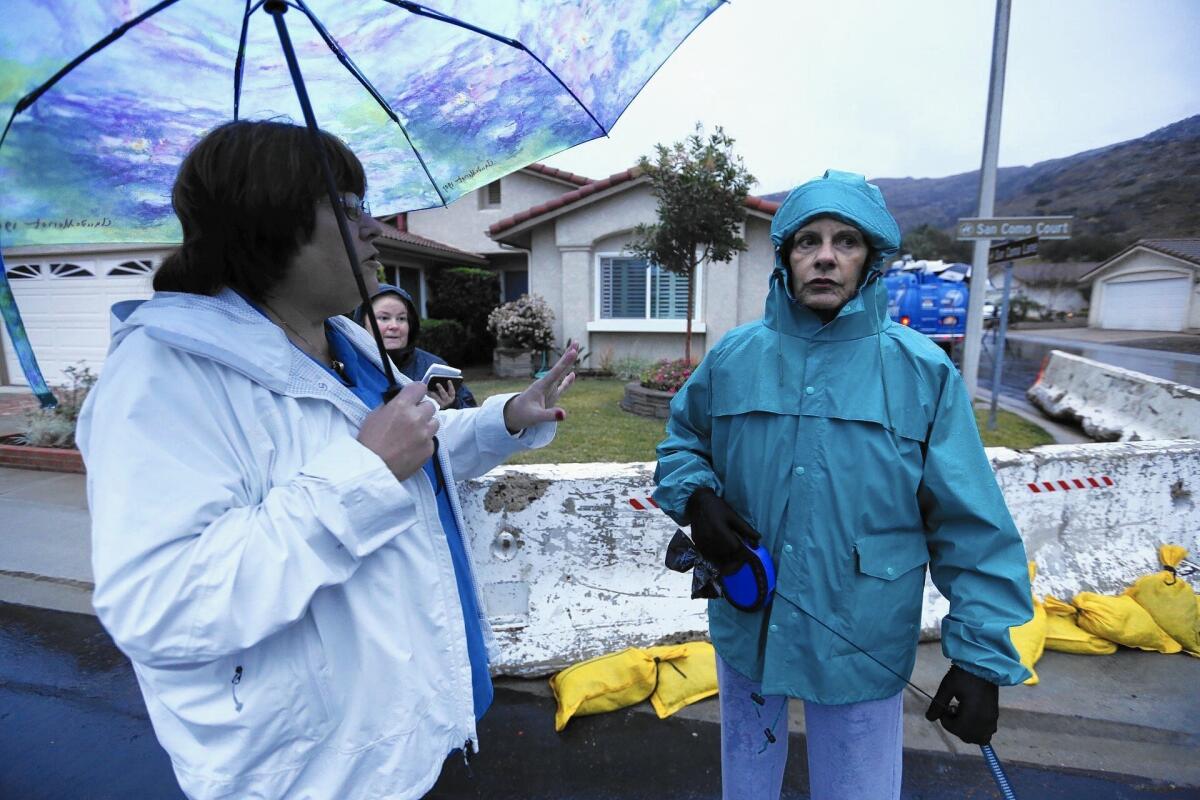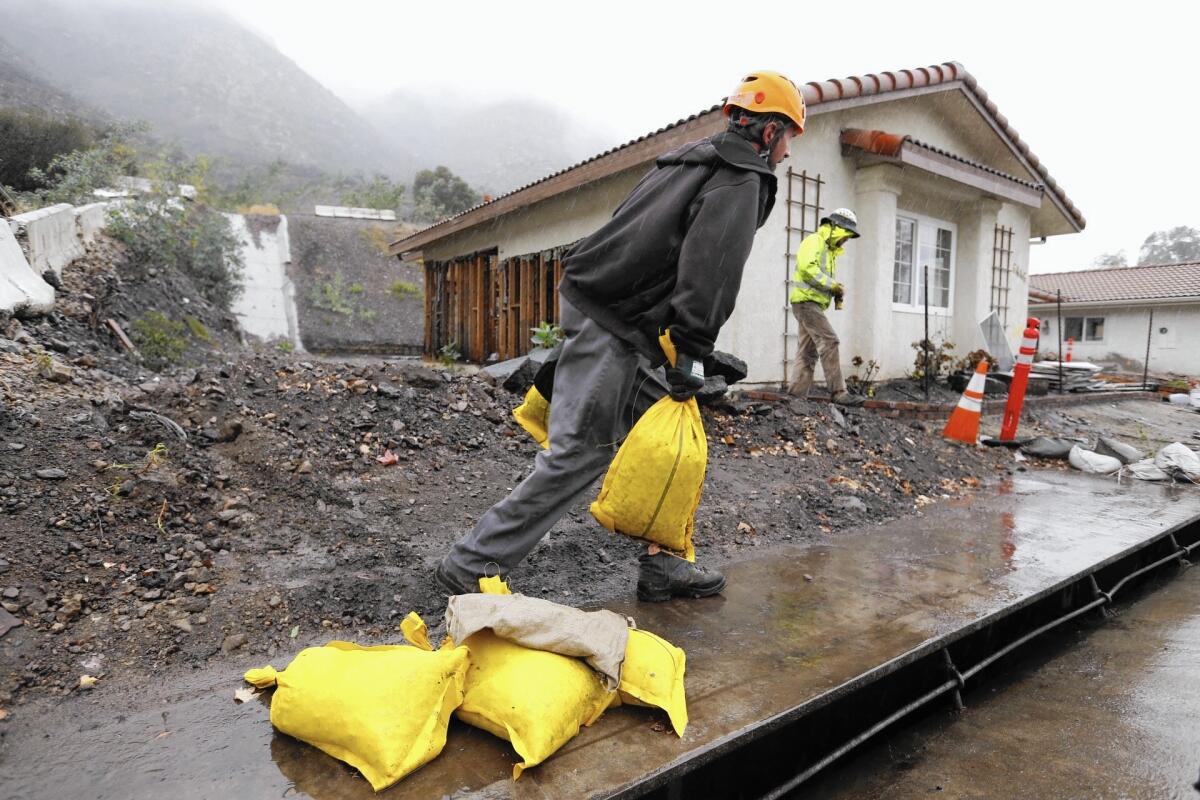California Journal: Rainstorms and mudslides mar the California wintertime postcard

- Share via
Reporting from Camarillo Springs — At moments like these — when the rain is sheeting, debris is cascading off burned mountainsides and mudslides are an ever-present threat — the idea of living in a home nestled against a steep mountain sounds less like a dream and more like what the hell was I thinking?
You won’t get anyone to admit that, though, even here in Camarillo Springs, where a 2013 wildfire was followed in 2014 by two mudslides six weeks apart. Ten homes were badly damaged or destroyed.
Salvatore Palame, 66, lives across the street from a handful of red-tagged houses. When he moved here to San Como Lane from Santa Barbara in 2012, he fought with insurance companies that didn’t want to cover his home.
FULL COVERAGE: El Niño in California >>
“State Farm was the only agency that would insure me,” he said. “I told them, ‘There won’t be any problems.’ A year later, the frickin’ house almost burned down.”
Despite this week’s voluntary evacuation order, Palame stuck around his little community at the bottom of the steep Conejo Grade, where Thousand Oaks gives way to the Oxnard Plain.
“I went through five major fires in Santa Barbara,” he said. “It sounds like I’m being a tough guy, like I want to go down with the ship. But I’m just tired. Evacuations wear you out after a while.”

Jason Rivas carries sandbags on San Como Lane in Camarillo Springs, where residents are under a voluntary evacuation order.
I was not thrilled to be out in the rain on Wednesday — it took me two hours to find a store with a rain poncho left on its shelves — but I wanted to see what was happening here, and all along Highway 101 in Ventura County, which has taken some of the hardest punches from the first of what are expected to be many El Niño-generated storms.
After I bumped into Palame, I met up with Barbara Williams, president of the local homeowners group. Standing in the drizzle, she happily told me that a hitherto untested system of debris barriers on the steep hill above the neighborhood seemed to be working perfectly.
That was when Mr. Doom and Gloom pulled up in a black SUV.
“Hey, Elton!” Williams yelled. “The platforms worked! I was here! Massive amounts of water and light stuff came down, but everything did as it was supposed to. The barriers worked!”
Elton Gallegly, the retired Republican congressman, didn’t look too impressed. “The barriers served their purpose,” he said, sitting in his truck, “but are they going to be there to serve the next purpose? This is the second day of probably 40 or 50 days of storms.”
“I know,” Williams said.
Gallegly has reason to be skeptical. He and his wife are the trustees of a home on Gitana Avenue. It was badly damaged in the December 2014 slide. The home’s caretaker and his daughter escaped with their lives.
And here was the crazy part, according to Gallegly: Emergency officials were already on high alert because of the previous slide, six weeks earlier. A staging area had been set up in front of their house, which faced the mountain.
The caretaker had arrived home about 10:30 p.m. and asked if he should evacuate. “They said, ‘No, we’ve got Doppler radar, reports from U.S. Weather. No problem. Go to bed.’”
Three hours later, awoken by the rumbling mountain, the tenant grabbed his daughter and made it over their back fence, a 15-foot drop, just ahead of the debris flow.
The house required $350,000 in repairs. Last week, Gallegly said, the city signed off on the final occupancy permits.
Just in time for El Niño 2016.
A few miles away, I met the couple who live next door to the Gallegly home. They were at a Red Cross evacuation center in a retirement community called Leisure Village. Paul Doebler, 85, and his wife, Terry, 82, had spent nearly five months in a hotel room while their home underwent repairs.
“We didn’t hear anything that night,” Paul said.
“What are you talking about?” said Terry, whose hearing has become acute after losing most of her eyesight to glaucoma. “You were asleep. I heard the roar.”
Join the conversation on Facebook >>
The Doeblers had decided to mind the evacuation order because they didn’t want to be there should the new fencing system above their house fail. The Red Cross had fed them pizza for lunch, and they were planning to return home in the evening.
After I left the Doeblers, I drove toward La Conchita, the small beachside community that has suffered two devastating mudslides in the last 20 years.
The rain was coming down so hard that traffic on the 101 slowed to a crawl. At Seaward Avenue, an arc of water, perhaps 20 feet long, was shooting out of a hillside drain, drenching cars on the freeway. Did a fire hydrant break open?
I stopped to take a look. Five minutes later, a Ventura Water truck with two men in green fluorescent rain suits arrived. By then, the rain had ceased and the spray of water had subsided. “It’s crazy,” one of them told me. “We’ve seen a lot of things today.”
On my way home, I pulled off the freeway to take a last look at Camarillo Springs. The neighborhood was wet but peaceful. Frontyard citrus trees groaned with lemons and oranges. A California wintertime postcard.
Except for the temporary concrete barriers known as K-rails that were scattered around, strategically placed to direct mudflows away from homes. And a big sign at the entrance of a nature trail that warned: “Beware of rattlesnakes.”
Oh well, no place is perfect.
Twitter: @AbcarianLAT







